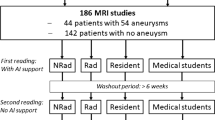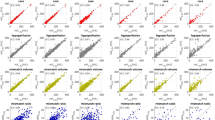Abstract
Objectives
To evaluate the feasibility of unenhanced motion-sensitized-driven equilibrium (MSDE)-prepared balanced turbo field echo (BTFE) sequences for detecting endoleaks after endovascular aneurysm repair (EVAR).
Methods
Forty-six patients treated with EVAR for aortic and/or iliac arterial aneurysms underwent contrast-enhanced CT and MSDE-prepared BTFE sequences with and without flow suppression. Two independent observers reviewed these sequences and their subtraction images and assigned confidence levels for detecting endoleaks. Relative contrast values were calculated by dividing signal intensities by those of paraspinal muscles. CT provided the reference standard.
Results
CT showed types I and II endoleaks in one and ten patients, respectively. Areas under receiver operating characteristic curves were 0.92 and 0.97 for observers 1 and 2, respectively. Sensitivity, specificity, accuracy, positive predictive value and negative predictive value of both observers were 91 (10/11), 91(32/35), 91 (42/46), 77 (10/13) and 97 % (32/33), respectively. Relative contrast values of endoleaks and flowing blood significantly decreased by flow suppression on MSDE-prepared BTFE images (P = 0.002 and P < 0.0001 respectively), and were significantly higher than those of the excluded aneurysms on subtraction images (P = 0.003 and P = 0.001, respectively).
Conclusions
Unenhanced MSDE-prepared BTFE sequences are feasible for detecting endoleaks.
Key points
• Flow suppression significantly reduces endoleak signals on MSDE-prepared BTFE images.
• Subtraction images of MSDE-prepared BTFE sequences ± flow suppression demonstrate endoleaks.
• MSDE-prepared BTFE sequences indicate high diagnostic values (>90 %) except PPV (77 %).
• MSDE-prepared BTFE sequences need further refinement to reduce false positives.
• Endoleaks can be detected without contrast injection using MSDE-prepared BTFE sequences.



Similar content being viewed by others
References
Desai ND, Burtch K, Moser W et al (2012) Long-term comparison of thoracic endovascular aortic repair (TEVAR) to open surgery for the treatment of thoracic aortic aneurysms. J Thorac Cardiovasc Surg 144:604–609
Lederle FA, Freischlag JA, Kyriakides TC et al (2012) Long-term comparison of endovascular and open repair of abdominal aortic aneurysm. N Engl J Med 367:1988–1997
The United Kingdom EVAR Trial Investigators, Greenhalgh RM, Brown LC et al (2010) Endovascular versus open repair of abdominal aortic aneurysm. N Engl J Med 362:1863–1871
Rozenblit AM, Patlas M, Rosenbaum AT et al (2003) Detection of endoleaks after endovascular repair of abdominal aortic aneurysm: value of unenhanced and delayed helical CT acquisitions. Radiology 227:426–433
Lehmkuhl L, Andres C, Luecke C et al (2013) Dynamic CT angiography after abdominal aortic endovascular aneurysm repair: influence of enhancement pattern and optimal bolus timing on endoleak detection. Radiology 268:890–899
Moll FL, Powell JT, Fraedrich G et al (2011) Management of abdominal aortic aneurysms clinical practice guidelines of the European society for vascular surgery. Eur J Vasc Surg 41:S1–S58
Hagiwara S, Saima S, Negishi K et al (2007) High incidence of renal failure in patients with aortic aneurysms. Nephrol Dial Transplant 22:1361–1368
Haulon S, Lions C, McFadden EP et al (2001) Prospective evaluation of magnetic resonance imaging after endovascular treatment of infrarenal aortic aneurysms. Eur J Vasc Endovasc Surg 22:62–69
Pitton MB, Schweitzer H, Herber S et al (2005) MRI versus helical CT for endoleak detection after endovascular aneurysm repair. Am J Roentgenol 185:1275–1281
Alerci M, Oberson M, Fogliata A et al (2009) Prospective, intraindividual comparison of MRI versus MDCT for endoleak detection after endovascular repair of abdominal aortic aneurysms. Eur Radiol 19:1223–1231
Grobner T (2006) Gadolinium-a specific trigger for the development of nephrogenic fibrosing dermopathy and nephrogenic systemic fibrosis? Nephrol Dial Transplant 21:1104–1108
Thomsen HS, Morcos SK, Almén T et al (2013) Nephrogenic systemic fibrosis and gadolinium-based contrast media: updated ESUR Contrast Medium Safety Committee guidelines. Eur Radiol 23:307–318
Wieners G, Meyer F, Halloul Z et al (2010) Detection of type II endoleak after endovascular aortic repair: comparison between magnetic resonance angiography and blood-pool contrast agent and dual-phase computed tomography angiography. Cardiovasc Intervent Radiol 33:1135–1142
Cornelissen SA, Prokop M, Verhagen HJ et al (2010) Detection of occult endoleaks after endovascular treatment of abdominal aortic aneurysm using magnetic resonance imaging with a blood pool contrast agent: preliminary observations. Invest Radiol 45:548–553
Ichihashi S, Marugami N, Tanaka T et al (2013) Preliminary experience with superparamagnetic iron oxide-enhanced dynamic magnetic resonance imaging and comparison with contrast-enhanced computed tomography in endoleak detection after endovascular aneurysm repair. J Vasc Surg 58:67–72
Iezzi R, Basilico R, Giancristofaro D et al (2009) Contrast-enhanced ultrasound versus color duplex ultrasound imaging in the follow-up of patients after endovascular abdominal aortic aneurysm repair. J Vasc Surg 49:552–560
Saida T, Mori K, Yabe H et al (2013) Noninvasive visualization of endoleaks after endovascular aortic aneurysm repair through unenhanced MRI with motion-sensitized driven equilibrium preparation: phantom experiments. J Magn Reson Imaging 38:714–721
Saida T, Mori K, Sato F et al (2012) Prospective intraindividual comparison of unenhanced magnetic resonance imaging vs contrast-enhanced computed tomography for the planning of endovascular abdominal aortic aneurysm repair. J Vasc Surg 55:679–687
Priest AN, Graves MJ, Lomas DJ (2012) Non-contrast-enhanced vascular magnetic resonance imaging using flow-dependent preparation with subtraction. Magn Reson Med 67:628–637
Rand T, Uberoi R, Cil B, Munneke G, Tsetis D (2013) Quality improvement guidelines for imaging detection and treatment of endoleaks following endovascular aneurysm repair (EVAR). Cardiovasc Intervent Radiol 36:35–45
Landis JR, Koch GG (1977) The measurement of observer agreement for categorical data. Biometrics 33:159–174
Resta EC, Secchi F, Giardino A et al (2013) Non-contrast MR imaging for detecting endoleak after abdominal endovascular aortic repair. Int J Cardiovasc Imaging 29:229–235
Sailer AM, Nelemans PJ, van Barlo C et al (2015) Endovascular treatment of complex aortic aneurysms: prevalence of acute kidney injury and effect on long-term renal function. Eur Radiol. doi:10.1007/s00330-015-3993-8
Acknowledgments
The scientific guarantor of this publication is Kensaku Mori. The authors of this manuscript declare relationships with the following companies: Philips Medical Systems provided the authors with the motion-sensitized driven equilibrium preparation pulse before selling on the market as a clinical science key. This study has received funding by Grant in Aid for Scientific Research (C) from Japan Society for Promotion of Science (JSPS KAKENHI); Contract grant number: 24591864. No complex statistical methods were necessary for this paper. The Ethics Committee for Clinical Research, University of Tsukuba Hospital approved this study. Written informed consent was obtained from all subjects (patients) in this study. Methodology: prospective, diagnostic or prognostic study, performed at one institution. The authors thank Masashi Shindo RT, Taketo Toki RT, Koji Yamada RT, and Takao Ishimori RT for their technical support.
Author information
Authors and Affiliations
Corresponding author
Rights and permissions
About this article
Cite this article
Mori, K., Saida, T., Sato, F. et al. Endoleak detection after endovascular aneurysm repair using unenhanced MRI with flow suppression technique: Feasibility study in comparison with contrast-enhanced CT. Eur Radiol 27, 336–344 (2017). https://doi.org/10.1007/s00330-016-4315-5
Received:
Revised:
Accepted:
Published:
Issue Date:
DOI: https://doi.org/10.1007/s00330-016-4315-5




